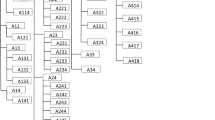Abstract
The usability of the website is a topic of great interest for researchers. The fuzzy MCDM approaches are widely adapted to measure and rank the usability of the website. These measures incorporate human input towards website are subjective in nature. Along with these measures, design dimension and other support features that encourage the user to reach desired information in stipulated time are equally important and should be incorporated in the proposed metric. These functions are objective in nature and hence suitable mathematical model or formulae can be used to evaluate its crisp value. In this paper a novel metric is proposed integrating objective and subjective approach, evaluating usability using fuzzy AHP and entropy method respectively. The proposed metric can be considered more accurate and complete as it includes expert input, experience of end user, design dimension and support features.





Similar content being viewed by others
References
Barber S (2010) How fast does a website need to be? http://www.perftestplus.com/resources/how_fast.pdf. Accessed 16 Sept 2015
Bevan N (2001) International standards for HCI and usability. Int J Hum Comput Stud 55(4):1–18
Bevan N, Kirakowsky J, Maissel J (1991) What is usability. In: Proceedings of 4th international conference on human computer interaction, Sept 1991. Elsevier, North-Holland
Bringula RP, Basa RS (2011) Factors affecting faculty web portal usability. Educ Technol Soc 14(4):253–265
Buckley JJ (1985) Fuzzy hierarchical analysis. Fuzzy Sets Syst 17(3):233–247
Caglar E, Mentes SA (2012) The usability of university websites—a study on European University of Lefke. Int J Bus Inf Syst 11(1):22
Chang E, Dillon TS (2006) A usability-evaluation metric based on a soft-computing approach. IEEE Trans Syst Man Cybern Part A Syst Hum 36(2):356–372
Chen SJ, Hwang CL (1992) Fuzzy multiple attribute decision making methods. Springer, Berlin, Heidelberg, pp 289–486
Deng H (1999) Multicriteria analysis with fuzzy pairwise comparison. Int J Approx Reason 21(3):215–231
Hasan L (2012) Evaluating the usability of nine Jordanian university websites. In: Proceedings of the international conference on communications and information technology, pp 91–96
Hongjiu L, Yanrong H (2015) An evaluating method with combined assigning-weight based on maximizing variance. Sci Program 2015:290379. doi:10.1155/2015/290379
Hsieh TY, Lu ST, Tzeng GH (2004) Fuzzy MCDM approach for planning and design tenders selection in public office buildings. Int J Proj Manag 22:573–584
Islam A, Tsuji K (2011) Evaluation of usage of university websites in Bangladesh. DESIDOC J Libr Inf Technol 31(6):469–479
Liu W, Cui J (2008) Entropy coefficient method to evaluate the level of sustainable development of China’s sports. Int J Sport Sci Eng 2(2):72–78
Naghadehi MZ, Mikaeil R, Ataei M (2009) The application of fuzzy analytic hierarchy process (FAHP) approach to selection of optimum underground mining method for Jajarm Bauxite Mine, Iran. Expert Syst Appl 36(4):8218–8226
Nagpal R, Mehrotra D, Sharma A, Bhatia P (2013) ANFIS method for usability assessment of website of an educational institute. World Appl Sci J 23(11):1489–1498
Nagpal R, Mehrotra D, Bhatia PK, Sharma A (2015a) FAHP approach to rank educational websites on usability. Int J Com Dig Syst 4(4):251–260
Nagpal R, Mehrotra D, Kumar Bhatia P, Sharma A (2015b) Rank university websites using fuzzy AHP and fuzzy TOPSIS approach on usability. Int J Inf Eng Electron Bus 7(1):29–36
Nielsen J (1993) Usability engineering. Academic Press, Boston. ISBN: 0-12-518405-0
Saaty TL (1990) How to make a decision: the analytic hierarchy process. Eur J Oper Res 48(1):9–26
Savoia A (2001) Web page response time. Softw Test Eng Mag 48–53
Shannon CE (1948) A mathematical theory of communication. Bell Syst Tech J 27:379–423
Shi L, Yang S, Li K, Yu B (2012) Developing an evaluation approach for software trustworthiness using combination weights and TOPSIS. J Softw 7(3):532–543
Torrente MCS, Prieto ABM, Gutiérrez DA, De Sagastegui MEA (2013) Sirius: a heuristic-based framework for measuring web usability adapted to the type of website. J Syst Softw 86(3):649–663
Wang J, Senecal S (2007) Measuring perceived website usability. J. Internet Commer 6(4):97–112
Zadeh LA (1975) The concept of a linguistic variable and its application to approximate reasoning—II. Inf Sci (NY) 8(4):301–357
Zhang H, Polytechnic W (2015) Application on the entropy method for determination of weight of evaluating index in fuzzy mathematics for wine quality assessment. Adv J Food Sci Technol 7(3):195–198
Zou Z, Yun Y, Sun J (2006) Entropy method for determination of weight of evaluating indicators in fuzzy synthetic evaluation for water quality assessment. J Environ Sci 18(5):1020–1023
Author information
Authors and Affiliations
Corresponding author
Appendix
Appendix
-
1.
Check the availability of the fee structure in the given web site of college.
-
2.
Find the hostel details of the given college.
-
3.
Find the placement details of the given college.
-
4.
Find the details of the placements in regard to students who got placed during campus recruitment process.
-
5.
Find the in-campus services (medical facility, canteen, sports facility) mentioned in the given website of a college.
-
6.
Find the services offered by library in the given website of a college.
-
7.
Find the details of the available departments in the given website of a college.
-
8.
Check the availability of news and events of a college in the given website.
-
9.
Find the details of research and development department in the website of a given college.
-
10.
Check the availability of alumni details in the given website of the college.
-
11.
Check for circular and notices.
-
12.
Are you able to find the “CONTACT US” tab on the home page.
-
13.
Is any “PHOTO GALLERY” available.
-
14.
Information regarding the MOUs and accreditation.
Rights and permissions
About this article
Cite this article
Nagpal, R., Mehrotra, D. & Bhatia, P.K. Usability evaluation of website using combined weighted method: fuzzy AHP and entropy approach. Int J Syst Assur Eng Manag 7, 408–417 (2016). https://doi.org/10.1007/s13198-016-0462-y
Received:
Revised:
Published:
Issue Date:
DOI: https://doi.org/10.1007/s13198-016-0462-y




